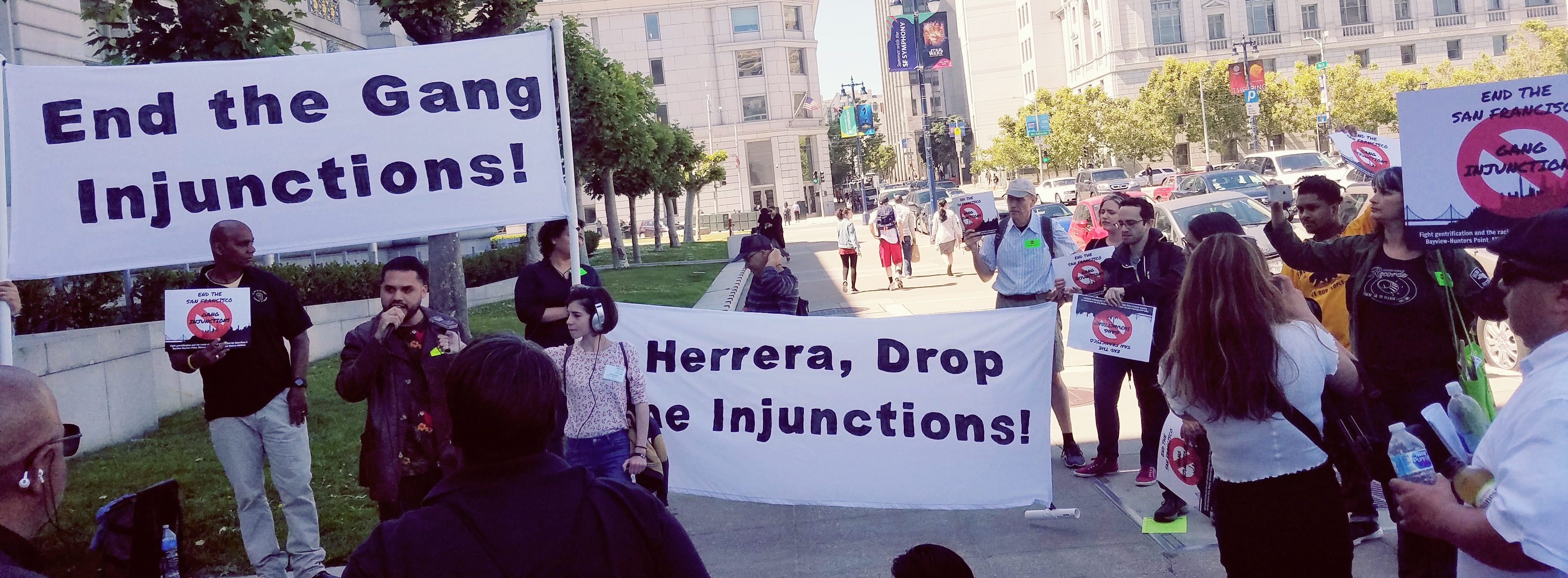In 2007, San Francisco City Attorney Dennis Herrera obtained 7 gang injunctions in 4 neighborhoods (Bayview-Hunters Point, Mission, Visitacion Valley, and Western Addition). Today, 53 men remain enjoined on the injunctions. The community is fighting back against the injunctions because:
- Every single person ever named on the injunctions is a black or brown male. This is a total of 150 black and brown San Franciscans and their families. Even though SFPD has ample documentation about several white gangs, the City Attorney has never targeted them.
- “Gang Policing” criminalizes and stigmatizes entire communities. Research shows that injunctions increase police harassment and surveillance (particularly for youth of color). They can give police even more reasons to detain and harass all members of a community. They have the power to prevent family members from associating with one another; at least seven sets of brothers (and many cousins) were named in San Francisco’s injunctions. Additionally, not all people named in the injunctions actually are – or ever were – gang members.
- Injunctions fuel gentrification and displacement. San Francisco is living through a crisis of gentrification and displacement. Residents are increasingly unable to afford housing in the city and Black San Franciscans now make up less than 6% of the city’s population. Gang injunctions have been implemented in some of the San Francisco neighborhoods hit hardest by gentrification. It is difficult to see this as a coincidence.
- Injunctions are a failed experiment. Other CA jurisdictions, some much less progressive than SF, have already moved away from this draconian, racist policy. Oakland ended its injunctions in 2015. In 2017, a court battle led both Stanislaus County to suspend its injunctions and Ventura County to halt enforcement against 368 people. LA purged thousands on its own, and then in March a federal court found major constitutional violations and forced LA to stop enforcing almost all its remaining injunctions. Shortly afterward, Long Beach stopped enforcing injunctions against 850 people and Orange County released 200 people from their injunctions. San Diego is now reviewing their decades-old injunctions and looking to remove hundreds.
- Herrera has not upheld his agreement to review the injunctions. Due to pressure from the community and civil rights organizations, Herrera agreed in 2008 to conduct reviews of the injunctions every three years. Although he did remove a few people in the first few years, he’s provided no evidence that he did full reviews until we forced him to this year. Additionally, if he had done the reviews as agreed, 13 deceased people would have been removed during that time – including Mario Woods, who was shot by police in his own neighborhood.
- Gang injunctions just keep losing in the Courts… including the 2013 Ninth Circuit opinion in Vasquez v. Rackauckas, the December 2017 appellate court decision in People v. Sanchez, and now the 2018 District Court decision in Youth Justice Coalition v. City of Los Angeles. Civil rights violations abound.
- We should be investing in programs that WORK, not criminalization! Studies show that investing in services and programs that keep people out of courts, jails, and prisons are more effective at improving public safety and promoting community well-being than investing in law enforcement. Let’s invest in education, stable housing, after-school activities, youth development, violence prevention, job training/placement, and drug treatment.
SF NIC Fact Sheets and Resources
Other Fights Against Gang Injunctions
Stop the Injunctions in Oakland
No to Orange County Injunctions – website and Facebook
More Resources
ACLU gang injunctions fact sheet
Analysis: The Unconstitutionality, Ineffectiveness, and Alternatives of Gang Injunctions
